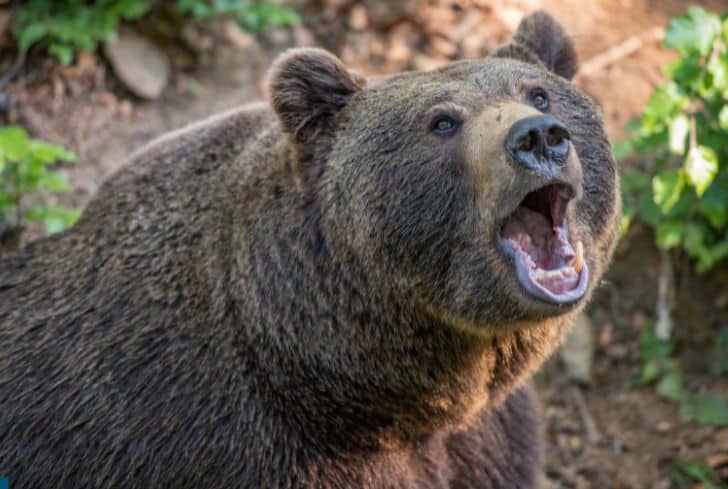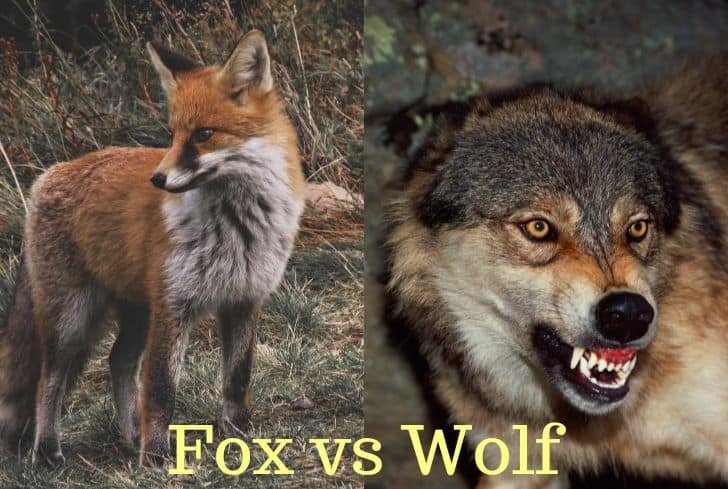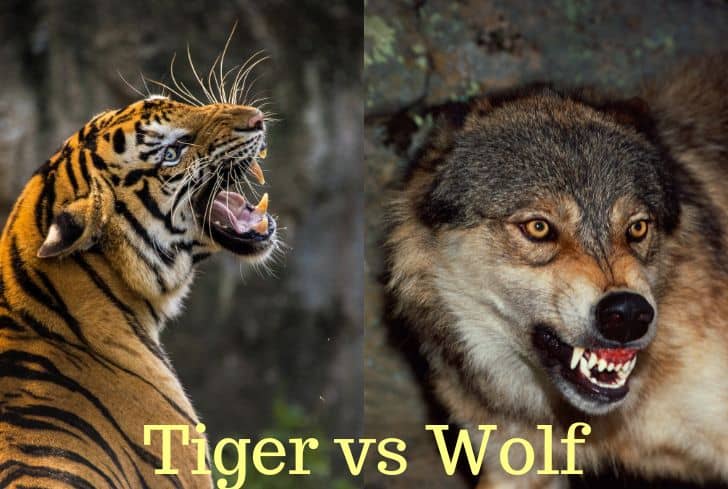Wolf vs Bear: Who Would Win in a Fight?

We usually consider wolves being the top dog in the canine family while bears are amazing in their own right. In this article, we will compare the specifics of what makes a wolf a wolf and what makes a bear a bear before figuring out which one would win in a fight.
What is a Wolf?
The wolf also known as the gray wolf or grey wolf, is a large canine native to Eurasia and North America. They have pointed ears, elongated snouts, and bushy tails that curl behind them as a means of expression. The average wolf typically weighs somewhere between 80 and 160 pounds. Wolves can live up to 13 years in the wild, but most die long before that age.
What is a Bear?
Bears are carnivoran mammals of the family Ursidae. These are typically found in the continents of North America, South America, Europe and Asia. Among all the 8 species of bears, only the polar bear is mostly carnivorous. The rest of them are omnivorous with varied diets. The bears have large body, small rounded ears, stocky legs, long snouts, short tail and shaggy hair. Despite their bulky size, they are excellent runners, swimmers and climbers.
| Characteristic | Wolf | Bear |
| Family | Canines | Caniform |
| Length | 2 meters or. 6.6 feet long | 4.5 feet long |
| Weight | 14 to 65 kilograms or 31 to 143 lbs. | 130 to 660 lbs for a male and 90 to 180 lbs for a female. |
| Height | 76 cm or 30 inches | 3 feet high on all fours and 5 to 8 feet tall when standing upright. |
| Habitat | North America, Eurasia/ Tundra, woodlands, forest, grasslands, and desert habitats | North America, South America, Europe, Asia/Mountains, woodlands, deserts, high mountains, and forests. |
| Food | Carnivores | Omnivores |
| Bite Power | 400 PSI | 800 PSI |
| Speed | 31 to 37 mph | 30 mph |
| Color | Combination of white, brown, gray, and black | Black, brown, cinnamon, blonde, blue-gray, or white. |
| Sound | Howling, whimpering, growling, and barking. | Huff, chomp, woof, growl, or bark. |
| Paws | Large, oval paws with four toes. Long middle toe. | Bears are flat-footed with their largest toe being on the outside of their feet. 5 toes were on both the front and hind part of the foot. |
| Senses | Good sense of smell, can see in the dark and process rapid movement, and can hear high-pitched sounds. | Acute hearing and their smell is their strongest sense. |
Wolf vs Bear [Differences & Strength Comparison?]
In this section, we will take a deeper look at the chart and delve into the differences between a wolf and a bear.
Wolf vs Bear: Family
The wolf belongs to the canine family, and the lion belongs to the feline family. There are 38 subspecies of wolves and can be found in North America, Europe, and Asia.
For bears, they belong to the Caniform family. The interesting part about this family of animals is that we consider all animals that fall under this name to be dog-like animals. They aren’t dogs but are dog like, which is pretty near when you think about it.
Only about eight species of bears currently exist. The rest have gone extinct, which is partially the fault of humans.
Wolf vs Bear: Size
You’ll find that wolves are the largest living member of the canine family so you can imagine that they are on the larger size. A male wolf is usually around 2 meters or. 6.6 feet long. This also includes the tail. Females are about 20 percent smaller than males.
Now for bears, we are specifically going to be focusing on black bears since they are one of the most common bears to be found in North America. Bears can get about 4.5 feet long. If you’ve ever seen a bear, you are not that surprised they are so large.
Wolf vs Bear: Weight
A wolf’s weight can range from 14 to 65 kilograms, or 31 to 143 pounds. You need to recall that a female wolf is usually twenty percent smaller, so that is also something that needs to be factored in.
The bear’s weight depends on whether it is a male or female. The male bear can weigh between 130 to 660 lbs. And 90 to 180 lbs. For a female. While the female bear can get to a decent weight, the weight range of a male bear is large.
Imagine coming face to face with a male bear that is at 660 lbs. That definitely wouldn’t be fun!

Wolf vs Bear: Height
The wolf stands about 76 centimeters or 30 inches tall at around the shoulder. Recall that they are the largest canines in the dog family, so this is a pretty impressive sign. If you compared them to other dogs, then they would definitely tower over them to an extent.
Bears stand about 3 feet high on all fours and 5 to 8 feet tall when standing upright. You may have seen a bear on TV when they stand on their two feet. It’s quite a frightening sight. If you ever see a bear doing this, best to tuck yourself into a ball.
Wolf vs Bear: Habitat
Wolves are more widely dispersed and found in North America and Eurasia. I can find them in places in North America like Alaska, Michigan, Wisconsin, Montana, Wyoming, Oregon, Idaho, and even Arizona or New Mexico. Habitat wise, they can live in the tundra, woodlands, forest, grasslands, and deserts.
You can usually find bears in North America, South America, Europe, and also in Asia. Mountains, woodlands, deserts, high mountains, and forests are the type of habitats that bears tend to live in. It is pretty varied and more than wolves if you decide to compare the two!
Wolf vs Bear: Food
Wolves are carnivores (meat eaters) and especially love eating large, hoofed animals like bison, elk, deer, and moose. They can eat smaller mammals if necessary. This includes such animals like beavers, mice, rats, and hares.
Unlike wolves, bears are omnivores, meaning that they eat both meat and plant products. Usually, bears will eat berries, fruit, insects, and sedges. They sometimes eat fish, honeycomb, human food, and garbage as well. If they find themselves hungry, they will not hesitate to travel onto a human’s property. This is happening more and more than bears’ natural habitats are being destroyed.
Wolf vs Bear: Bite Power
The wolf has the strongest bite force in the canine family. Their bite force is around 400 PSI or pounds per square inch. It is weaker than a bear, but still pretty impressive if you think about it.
Now the bear has a strong bite force. Their PSI, or pounds per square inch, is at about 800. This is double the bite power of a wolf, so imagine if a bear bit down on a wolf. It would not end up very well for the wolf! Not saying the wolf couldn’t cause any damage to a bear, but one is stronger than the other.
Wolf vs Bear: Speed
A wolf’s range of speed falls between 31 to 37 miles per hour. There are a lot of factors that impact a wolf’s speed, but it will usually fall somewhere in that range.
For bears, they can run as fast as 30 mph. Bears are exceptionally large animals, heavy animals, but you should know that they are very agile animals. They can run amazingly fast and with not much trouble, either. People may not associate such terms with bears, but they really should give them some more credit. They are truly graceful animals when you think about it.
Wolf vs Bear: Color
The most common color of a wolf’s coat is a mixture of white, brown, gray, and black. Interestingly enough, there are subspecies in the arctic region that could be completely white.
We are focusing on black bears so this is the animal that we are going to discuss here. Black bears, despite the names, can have a coat that is many colors. I can find them with such coats that are black, brown, cinnamon, blonde, blue-gray, or white.
Wolf vs Bear: Sound
Wolves communicate with howling, whimpering, barking, and growling. There could even be a mixture of sounds like a bark-howl or growl-bark.When people think of wolves, they think of their howling at the moon late at night. This is true because wolves do howl, but they also make other sounds.
Bears make a lot of interesting sounds, and this includes more than a growl. They can make such sounds like huffs, chomps, woofs, growls, or barks. Usually, when people think about bears, they think of growling, and that’s all they are going to do. However, bears can make a lot more sounds than just growls.

Wolf vs Bear: Paws
Wolves have four toes and an oval-shaped paw. The biggest difference is that the middle toe of a wolf is usually longer, with webbing that can be found between their toes.
The bear has a flatfooted foot with their largest toe being on the outside of their feet. 5 toes on both the front and hind part of the foot. If you were to place a wolf’s paw next to a bear’s paw, there would be a large size difference between the two of them.
Given the size difference between the two, this should not be a surprise.
Wolf vs Bear: Senses
All the wolves ‘ senses (hearing, smell, vision) are impressive. They have a strong sense of smell, can see in the dark and process rapid movement, and can hear high-pitched sounds. All especially useful for when they want to find their prey or avoid predators.
Bears have exceptionally good senses. They have acute hearing, and their smell is their strongest sense. A bear can smell a respectful distance away and might even smell you if they were going for a walk in the forest and you were nearby.
Who Would Win in a Fight? Wolf or Bear
So, we are once again at the last question. Who would win if there was a fight between a wolf or a bear? On the one hand, wolves are quicker than bears, not by much, but still a decent amount. Then consider that wolves travel in packs. If a pack of wolves were to come up against a bear, they just might beat it in a fight.
What if it was one-on-one though? Well, the bear is going to win hands down. They are much heavier than wolves, about 3 times as heavy as them sometimes. Also, consider their bite power that is twice as powerful as the wolf’s bite power. One bite and the wolf would be out of commission.
Again, the wolf is still a fearsome animal in its own right. We are not saying that it isn’t, but if it is going up against an animal as strong as a bear, it is going to need some help from the rest of its pack. Only then will they even have a chance of taking down a bear.
Still, the bear could cause some damage to a pack of wolves as well. These are gigantic and powerful animals that can cause a lot of damage to whatever they are fighting or attacking.
Final Thoughts
And there we have it all, our dear readers and animal lovers out there. There are a lot of amazing things about bears and wolves that we learned about in this piece. The comparisons between the two are pretty amazing, to be honest. However, after comparing them, it’s pretty obvious that the obvious winner is the bear.
The bear is stronger than the wolf in every way possible. They are larger than wolves. Actually, much heavier to be honest. Then you have to take their bite power into account as well, which will take down the wolf in one or two bites.



![Coyote vs Wolf [Differences & Strength Comparison]](https://eartheclipse.com/wp-content/uploads/2022/08/Coyote-vs-wolf.jpg)
![Hyena vs Wolf [Differences & Strength Comparison]](https://eartheclipse.com/wp-content/uploads/2022/08/Hyena-vs-Wolf.jpg)
